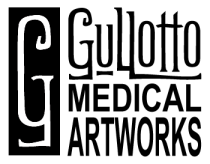About Meg
Why Medical Illustration?
The Value of the Medical Illustrator:
When I first considered medical illustration as a career choice, I had already been introduced to a facet of it by way of my mother’s profession. Her law firm frequently commissioned artwork, diagrams, and other documents to show in court during cases of medical malpractice. At the time, this was my only exposure to an actual job that involved both the word “art” and the word “medical”. And I wasn’t terribly impressed or ready to dedicate my life to such a concept. I had no real appreciation then of just how much the term “medical illustration” really encompassed. Once I became aware of all the ways in which it was applied, I realized that this tiny, exclusive little profession was actually an overlooked but incredibly vital educational tool. I believe that without it, we might still be fumbling in the dark ages of medicine and health care.
Above all, the practice of creating artwork to depict anatomy, a surgical procedure, the progression of a disease, or the effects of medicine, is meant to teach and to inform. That is its primary purpose. As knowledge is our greatest strength, this practice is invaluable. And within this broad purpose, it fills a multitude of specific needs. The most obvious, the most well known, is naturally the illustration of textbooks. Where would we be if there were no clear, carefully rendered images to help teach future generations of doctors, nurses, therapists, and so on? Hands-on learning is irreplaceable, of course, but what to do when a surgical student can’t quite remember where a certain nerve should be? Once upon a time, the only accurate way to see inside the human body was to open it up. Would this have been an efficient way to teach generations of students? Imagine learning how to remove someone’s spleen with only a block of text to help you understand what you are seeing over the shoulder of the surgeon in front of you. Or perhaps you try to decipher a photograph of the surgery, trying to figure out which squishy pink thing is which. Would you trust a surgeon to operate on you with that information alone? Images created by an artist have the ability to show what photographs and video cannot, which leads to greater understanding that is much more quickly reached. This education is one of the main reasons we respect and put trust in our physicians. And happily, their education doesn’t end with school. Medical journals, another area that benefits from illustrations, are often specialized to individual fields and help keep our medical professionals apprised of the latest techniques and developments, and they, in turn, take better care of us.
However, artists are also employed to communicate with the public directly. Once again, the purpose of the work they create is to inform and to educate. Sometimes it does this by being so cleverly eye-catching on the front of a magazine that we’ll pick it up to learn more. Sometimes it’s used to make us want to reach for a pamphlet in the waiting room. We may not know what those colorful ribbons are passing through the picture of a pair of lungs, but it’s just so pretty compared to the ugly waiting room wallpaper that we’ll pluck it from the stack and start reading about a new medication that helps patients breathe. One of the largest and most appreciated uses of medical illustration is the education of patients and the families of patients. In the same way we prefer our instruction manuals to have pictures, we learn new information better when we have words accompanied by images. And when it is extremely important that a patient understand and retain new information being given them by their doctors, illustrations are key. A medical illustrator has the unique skills to comprehend the complex anatomy, medicine, and procedures involved and to translate them into forms more palatable to the average patient. What’s more, they have the ability to tailor their work to suit a specific audience. And while static images are the most often called for, the term “illustration” can also include animations and interactive tools that are often even more effective at reaching and informing patients.
Reaching patients (and potential patients) is a tactic that more commercial industries also employ. Illustrators and animators are used constantly to promote healthcare services and products. Television is absolutely flooded with them, and when done well, they can be very effective, and most importantly, memorable. It can range from the promotion of medications to the hard facts about disease prevention. Those who are taught the facts are far more likely to make smarter decisions about their health.
Finally, the business which first introduced me to the idea of applying art to medicine: the legal world. Juries must be given all of the facts, simply, accurately, and without bias, whether it be the details of a surgery gone wrong, the injuries sustained in an accident, or any other depiction in which photos are unavailable or impossible. If a piece of medical equipment failed and caused a patient to stop breathing, an illustration can show the causes and effects of oxygen deprivation. If a jury must decide the amount to award the plaintiff, they understand the damage done by a car wreck much more clearly if they can see all the fractures in a passenger’s leg. Once more, the artist must be able to translate all the salient facts of a case and provide the clearest information so that the jury can learn quickly and without confusion.
Medical illustrators may be rare creatures, unseen and underappreciated, but I have learned how vitally important they are to the flow of medical knowledge through each level of our society, and I am proud to be one of them. After all, where else would we get those nifty posters we stare at in the doctor’s office?


